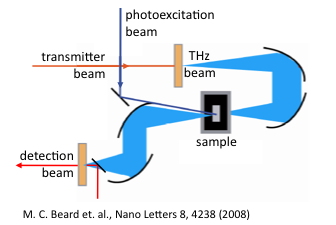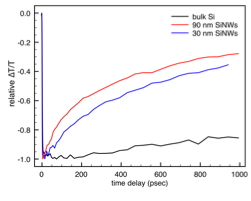Furtak Research Projects
Nanomaterials in Photovoltaic Systems
Current commercial photovoltaic technologies are limited by the cost and efficiency of material systems. These are defined by the physics of a standard solid state junction, which constrains the power conversion efficiency to no more than 33.7%. If the cost of producing solar cells could be reduced, or the effiency could be increased, photovoltaics could be economically practical.
 One way to overcome these limitations is to exploit the properties of nanoparticles and nanowires. This is the goal of IRG1-Materials for Next Generation Photovoltaics within the Renewable Energy Materials Research Science and Engineering Center. As part of this effort, we are collaborating with Matt Beard at NREL to perform high-speed optical characterization of silicon nanostructures. Recent experiments used terahertz (THz) absorption spectroscopy to monitor photocarrier generation and relaxation in Si nanowires.
One way to overcome these limitations is to exploit the properties of nanoparticles and nanowires. This is the goal of IRG1-Materials for Next Generation Photovoltaics within the Renewable Energy Materials Research Science and Engineering Center. As part of this effort, we are collaborating with Matt Beard at NREL to perform high-speed optical characterization of silicon nanostructures. Recent experiments used terahertz (THz) absorption spectroscopy to monitor photocarrier generation and relaxation in Si nanowires.
Time-resolved THz spectroscopy (TRTS) is uniquely suited to investigate photo-induced charge generation and transport in nanoscale material systems. In a TRTS experiment, a visible or near-IR pump pulse excites a sample and a THz probe pulse measures the response in the far-infrared (typically spanning a frequency range from 5cm-1 to 100cm-1). The THz pulses are measured in the time domain at the electric field amplitude level so that the sample's complex-valued, frequency-dependent conductivity is measured without the need for attaching wires. A temporal resolution between the pump and probe pulses of 200fs or better can be achieved.
 Our objective is to study silicon nanowires (SiNWs) as a function of wire diameter, and to characterize the influence of surface treatments on the carrier dynamics of these structures. The samples were provided by Prof. Joan Redwing and Postdoc Chito Kendrick at Penn State University, where SiNWs are under study for their promise as radial-junction photovoltaic devices. The SiNWs are grown by chemical vapor deposition on c-plane sapphire substrates using 5-nm gold nanoparticles as catalysts to promote NW growth by a vapor-liquid-solid (VLS) process. Any remaining metallic gold was removed prior to the THz measurements. The SEM photograph shows 90nm wires, as grown. These were oxidized to create 30nm wires. All native and thermal oxides were removed with hydrofluoric acid to leave the surfaces hydrogen terminated.
Our objective is to study silicon nanowires (SiNWs) as a function of wire diameter, and to characterize the influence of surface treatments on the carrier dynamics of these structures. The samples were provided by Prof. Joan Redwing and Postdoc Chito Kendrick at Penn State University, where SiNWs are under study for their promise as radial-junction photovoltaic devices. The SiNWs are grown by chemical vapor deposition on c-plane sapphire substrates using 5-nm gold nanoparticles as catalysts to promote NW growth by a vapor-liquid-solid (VLS) process. Any remaining metallic gold was removed prior to the THz measurements. The SEM photograph shows 90nm wires, as grown. These were oxidized to create 30nm wires. All native and thermal oxides were removed with hydrofluoric acid to leave the surfaces hydrogen terminated.
 The THz absorption data show the time dependence of photogenerated carriers. Surprisingly, larger diameter wires have smaller carrier lifetimes than smaller diameter wires. Measurements of the peak signal as a function of the intensity of the pump pulse show that the carrier mobility is also smaller in the larger diameter wires, compared to the smaller diameter wires. These results suggest that bulk impurities or defects dominate the dynamics. It is possible that gold from the VLS growth is contributing to recombination. The smaller diameter wires were thermally oxidized. TEM studies at Penn State revealed that gold migrates to the interface between the NW and the oxide and may be removed with the oxide. In addition, the crystalline quality of the NW may improve with the thermal treatment. Both effects would explain the better performance of the smaller diameter wires.
The THz absorption data show the time dependence of photogenerated carriers. Surprisingly, larger diameter wires have smaller carrier lifetimes than smaller diameter wires. Measurements of the peak signal as a function of the intensity of the pump pulse show that the carrier mobility is also smaller in the larger diameter wires, compared to the smaller diameter wires. These results suggest that bulk impurities or defects dominate the dynamics. It is possible that gold from the VLS growth is contributing to recombination. The smaller diameter wires were thermally oxidized. TEM studies at Penn State revealed that gold migrates to the interface between the NW and the oxide and may be removed with the oxide. In addition, the crystalline quality of the NW may improve with the thermal treatment. Both effects would explain the better performance of the smaller diameter wires.
In addition to collaborators Matt Beard and Joan Redwing, the research is a partnership with Reuben Collins, and is being conducted by grad student Matt Bergren.
